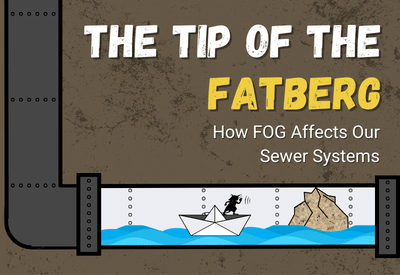The Tip of the Fatberg: How FOG Affects our Sewer System

Fats, oils, and grease, commonly referred to as FOG, are one of the most prevalent contributors to sanitary sewer blockages and overflows. In this blog, we will explore the impact of FOG and what can be done to control it.
Where does FOG come from and how are fatbergs formed?
Commercial and residential kitchens are the most common sources of FOG. When hot water and soap are used to wash these greases down the drain, they are carried into our wastewater infrastructure. This is common in restaurants that specialize in greasy foods, such as fast-food establishments, diners, and sports bars. Most restaurants are required to install grease traps to capture FOG before it enters the sewer system. However, if these grease traps are not properly maintained or undersized, they can become clogged or overwhelmed rendering them ineffective.
When FOG particles contact cooler water, they solidify and adhere to the inside of the sewer pipes. Over time, this buildup of FOG can create blockages that restrict the flow of wastewater—leading to backups and overflows. While detergents and degreasers can help break down FOG, they are not a long-term solution. For this reason, it is essential to evaluate the size and effectiveness of grease traps regularly and ensure they are functioning as intended.
The term “Fatberg” was originally coined after a 15-tonne blockage was discovered in the London sewer system. A “Fatberg” is created when FOG congeals on nonorganic materials, such as flushable wipes. The FOG goes through a chemical process called saponification resulting in a hardened, calcified mass that spells disaster for a collection system.
What methods are used to remove FOG from sewers?
Degreasers are used to liquefy FOG and break it down into smaller particles that can be flushed through the sewer system. However, once the degreaser dissipates, the FOG can re-solidify, restricting the flow of wastewater once again. As a result, detergents and degreasers should only be used as a short-term solution to FOG buildup in the sewer system. Over-reliance on these products can lead to other issues, such as excessive foam production and increased levels of contaminants in wastewater treatment facilities.
While degreasers can remedy small issues, they are ineffective against fatbergs. When a fatberg grows too large for degreasers, hydro jetting is required. Hydro jetting uses high-pressure water to blast away fat deposits. These high-pressure nozzles are often attached to vacuum trucks to suction out the fatberg debris. These hydro-jetting operations can take weeks to complete. In 2017, a Fatberg (aptly named “Fatty McFatberg”) took a team thirteen weeks to remove from the London Sewer. Measured at over 250 meters and weighing the equivalent of eleven double-decker buses, a team of eight would remove between 20-30 tonnes each day.
Overall, the best solutions to manage FOG buildup and fatbergs are regular maintenance, proper disposal of fats, and the use of grease traps. By implementing these best management practices in commercial kitchens and conducting regular evaluations of grease traps and sewer systems, utilities can reduce the need for costly repairs.
Identifying Problems Before They Become Problems
Like many other issues facing our collection systems, FOG build-up is inevitable. That’s why utilities must also take proactive action to identify potential blockages before they can cause a backup. Many utilities have a “hotspot” program where certain areas are identified as “high risk” for blockages. These areas are then flagged for more regular inspection and cleaning. These may be spots with older pipe infrastructure or an area with a high concentration of commercial kitchens.
CCTV has been the traditional choice for locating FOG buildup and Fatbergs. With CCTV cameras inserted in the pipe, operators can identify the blockage’s location and size. However, screening a system with CCTV can be a slow, expensive, and labor-intensive process.
The SL-RAT (Sewer Line Rapid Assessment Tool) is an acoustic tool that can assess sewer pipes’ condition and effectively prioritize FOG buildup hot spots. The SL-RAT works by emitting sound waves into a sewer pipe. If the sound signal can travel clearly through the pipe, it indicates that the pipe has additional flow capacity. However, if the sound waves are degraded or blocked, it suggests a buildup of FOG or other problems in the pipe. A robust program using acoustic inspection allows municipalities to quickly identify areas of concern. Pipes with a high level of FOG buildup can be cleaned proactively to prevent overflows or backups.